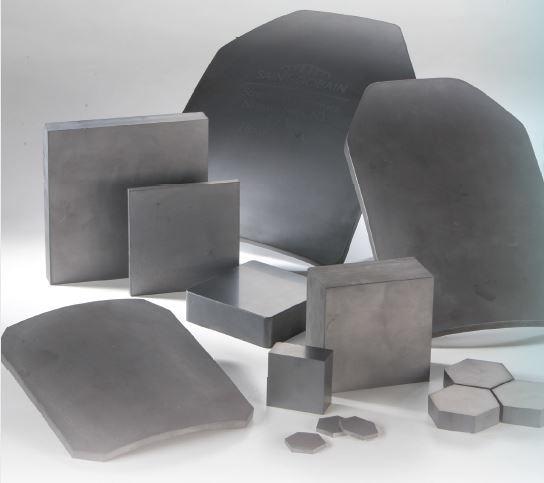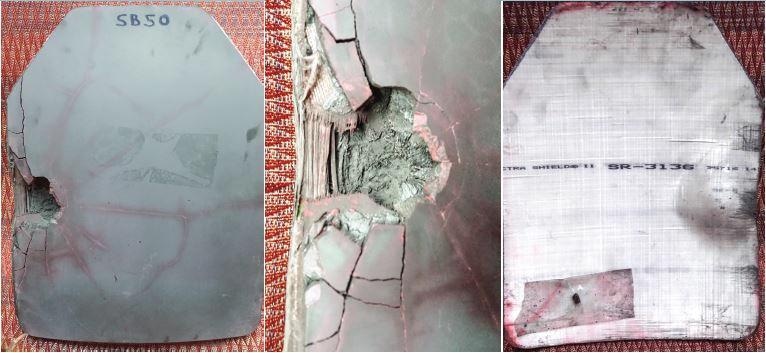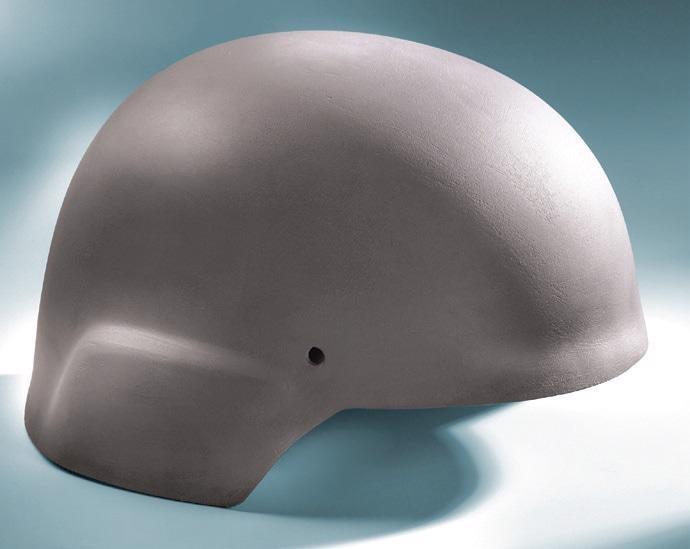Bullet-resistant vests, otherwise known as ‘body armor’ are typically used for protective purposes in modern day law enforcement, security, and military. The most efficient and effective body-shielding equipment ensures maximal defense with minimal additional weight. Ceramic materials, such as silicon carbide (SiC), are considered to be ideal for stopping rifle bullets due to their impressive strength and hardiness. SiC can be combined with backing materials and inserted into protective vests to provide vital body protection against any high-velocity projectiles. Saint-Gobain offers custom-designed armor materials made from Hexoloy® sintered SiC, a high-performance, a lightweight ceramic material designed to protect against current and emerging ballistic threats.

Figure 1. Sintered SiC Hexoloy® body and vehicle armor tiles by Saint-Gobain. (Credit: Saint-Gobain)
Body Armor Structure and Bullet Interaction
A typical rifle bullet includes a case, powder charge, and projectile. Projectiles that can pierce armor have a jacket, which is a sheath of a metallic alloy that surrounds a denser, stronger core generally made of steel or other very hard or dense materials. Once the gun is fired, this causes the powder charge to ignite and energy enters the projectile of the bullet.

Figure 2. Hardness of various types of ammunition and armor materials.2–6 Note that Vickers hardness of the lead antimony core 7.62 mm NATO ball is only 10 HV. (Credit: Saint-Gobain)
When the projectile comes into contact with an effective body armor material, its kinetic energy is spread across a much larger surface area than the original cross section and stops the projectile from piercing into the user’s body. The kinetic energy in a 7.62 mm AK-47 round is approximately 2,000 joules; this is comparable to being impacted by fourteen 100 mile-per-hour fastballs in an 0.07 square inch area!1 Clearly, armor materials must be extremely hardy in order to disperse the energy of a projectile and protect the body from consequent damage.

Figure 3. Hexoloy sintered SiC body panel after impact with a projectile. (From left) Front view of impact zone of plate; close-up of impact zone; and backside deformation of plate with projectile remains. (Credit: Saint-Gobain)
Ceramic Armor: Silicon Carbide
SiC was discovered 125 years ago by the American chemist Edward Acheson whilst trying to produce synthetic diamonds. Nowadays, this material is thought of as optimal for a wide variety of high-performance applications, including body protection.

Figure 4. Densities of armor materials. (Credit: Saint-Gobain)
When a projectile collides with a ceramic armor plate, the projectile’s jacket is removed. This exposes the projectile core, which wears away upon impact with the much harder ceramic. The SiC armor system and supportive backing absorbs the energy from the projectile and spreads this across the area of the vest. Any energy that is transmitted to the user is reduced to a level that is survivable; ultimately, the wearer is protected from deadly penetration and trauma during a ballistic event.
In addition to providing excellent protection from high-velocity, armor-piercing threats, one of the main benefits of SiC for use as armor is its light weight nature. For instance, Hexoloy®, a special sintered SiC from Saint-Gobain, weighs almost 2.5 times less than steel despite being one of the hardest materials after diamond.
In addition, sintered SiC ceramics are manufactured in a way that enables custom designed shapes, including intricate and complex curvatures. One-piece helmet designs, for example, demonstrate the high levels of complexity that can be achieved with such ceramics processing techniques. Ultimately, the design flexibility of Hexoloy® extends the number of real-world applications that this material can provide for.
The Next Generation of Ceramic Armor
Saint-Gobain Ceramics continues to focus on advancing the next generation of ceramic body armor. For instance, multiphase microstructures can now be achieved using new chemistries, and may provide a whole new level of protection as well as enabling users to adjust the weight to meet a particular protection level. Crucially, such developments mean that ceramic armor technology can keep up with any potentially emerging ballistic threats.

Figure 5. Advanced ceramic processing techniques can enable one-piece manufacturing of helmets made from armor materials. (Credit: Saint-Gobain)
In addition to the military and law enforcement who have utilized ceramic insert panels for some time, additional applications such as vehicle, architectural, structural, and civilian security are now also profiting from this technology.
For example, vehicle operations could benefit from the light weight properties of SiC armor. Such potential applications include wheeled, fixed and rotary wing, waterborne strike, and transport platforms. Depending on the situation at hand, the ceramic armor system could even be modular to improve the vehicle platform flexibility. Saint-Gobain offers reaction-bonded SiC armor with monolithic panel constructions and excellent multihit abilities, perfect for vehicular installations.
Summary
SiC is the ideal material for high-defense body armor, chosen for its excellent protection performance, advanced properties, and good adaptability to any threat level encountered. Manufacturers like Saint-Gobain Ceramics continue to invest in this application, and ceramic armor products continue to protect individuals across the world from both current and potential future ballistic threats.
References
- A.E. Hartink, The complete encyclopedia of automatic army rifles. Hackberry Press, 2001.
- P.J. Hazell, "Penetration of a glass-faced transparent elastomeric resin by a lead-antimony-cored bullet," Int. J. Impact Eng., 36, 147–53 (2008).
- N. Kiliç, et al., "Ballistic behavior of high hardness perforated armor plates against 7.62 mm armor piercing projectile," Materials & Design, 63, 427–38 (2014).
- J. Leeder, "Armor piercing bullets with sintered carbide cores." U.S. Army Aberdeen Research and Development Center, Ballistic Research Laboratories, Report No. 262, 1941.
- D. Ray, et al., "Effect of room-temperature hardness and toughness on the ballistic performance of SiC-based ceramics," Advances in Ceramic Armor: A collection of papers presented at the 29th International Conference on Advanced Ceramics and Composites, Jan. 23–28, 2005, Cocoa Beach, Fla., Ceramic Engineering and Science Proceedings, 26, 131–42, John Wiley & Sons, 2005.
- J.L. Zinszner, "Identification des paramètres matériau gouvernant les performances de céramiques à blindage," Doctoral dissertation, Université de Lorraine, France, 2014.

This information has been sourced, reviewed and adapted from materials provided by Saint-Gobain High-Performance Refractories. It is a derivative work based upon the article “Silicon Carbide for the Modern Warfighter” first published in ACerS Bulletin ©2017.
For more information on this source, please visit Saint-Gobain High-Performance Refractories.